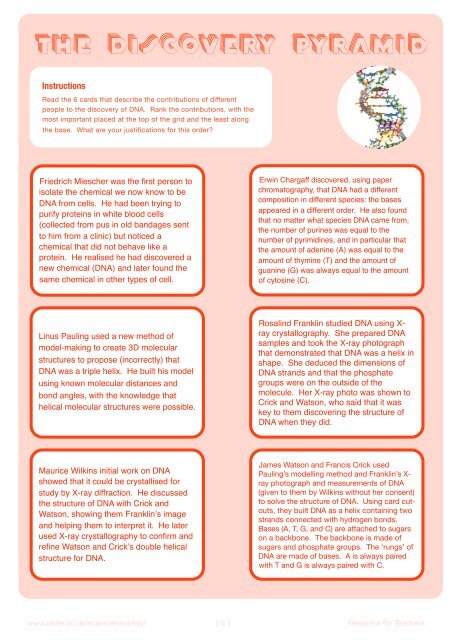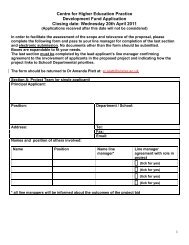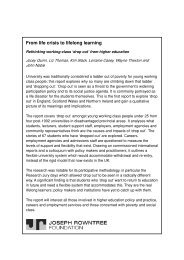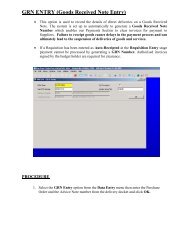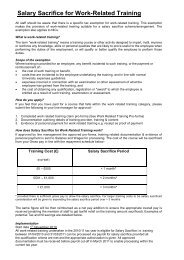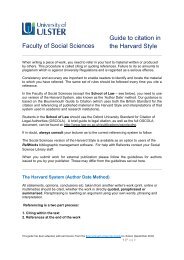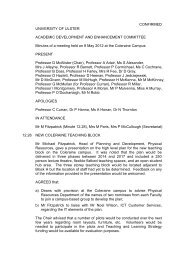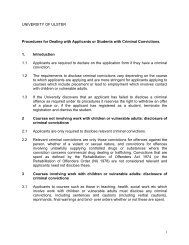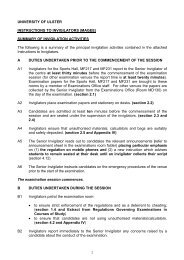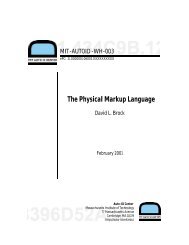You also want an ePaper? Increase the reach of your titles
YUMPU automatically turns print PDFs into web optimized ePapers that Google loves.
the <strong>discovery</strong> pyramid<br />
Instructions<br />
Read the 6 cards that describe the contributions of different<br />
people to the <strong>discovery</strong> of <strong>DNA</strong>. Rank the contributions, with the<br />
most important placed at the top of the grid and the least along<br />
the base. What are your justifications for this order?<br />
Friedrich Miescher was the first person to<br />
isolate the chemical we now know to be<br />
<strong>DNA</strong> from cells. He had been trying to<br />
purify proteins in white blood cells<br />
(collected from pus in old bandages sent<br />
to him from a clinic) but noticed a<br />
chemical that did not behave like a<br />
protein. He realised he had discovered a<br />
new chemical (<strong>DNA</strong>) and later found the<br />
same chemical in other types of cell.<br />
Linus Pauling used a new method of<br />
model-making to create 3D molecular<br />
structures to propose (incorrectly) that<br />
<strong>DNA</strong> was a triple helix. He built his model<br />
using known molecular distances and<br />
bond angles, with the knowledge that<br />
helical molecular structures were possible.<br />
Maurice Wilkins initial work on <strong>DNA</strong><br />
showed that it could be crystallised for<br />
study by X-ray diffraction. He discussed<br />
the structure of <strong>DNA</strong> with Crick and<br />
Watson, showing them Franklinʼs image<br />
and helping them to interpret it. He later<br />
used X-ray crystallography to confirm and<br />
refine Watson and Crickʼs double helical<br />
structure for <strong>DNA</strong>.<br />
Erwin Chargaff discovered, using paper<br />
chromatography, that <strong>DNA</strong> had a different<br />
composition in different species: the bases<br />
appeared in a different order. He also found<br />
that no matter what species <strong>DNA</strong> came from,<br />
the number of purines was equal to the<br />
number of pyrimidines, and in particular that<br />
the amount of adenine (A) was equal to the<br />
amount of thymine (T) and the amount of<br />
guanine (G) was always equal to the amount<br />
of cytosine (C).<br />
Rosalind Franklin studied <strong>DNA</strong> using Xray<br />
crystallography. She prepared <strong>DNA</strong><br />
samples and took the X-ray photograph<br />
that demonstrated that <strong>DNA</strong> was a helix in<br />
shape. She deduced the dimensions of<br />
<strong>DNA</strong> strands and that the phosphate<br />
groups were on the outside of the<br />
molecule. Her X-ray photo was shown to<br />
Crick and Watson, who said that it was<br />
key to them discovering the structure of<br />
<strong>DNA</strong> when they did.<br />
James Watson and Francis Crick used<br />
Pauling’s modelling method and Franklin’s Xray<br />
photograph and measurements of <strong>DNA</strong><br />
(given to them by Wilkins without her consent)<br />
to solve the structure of <strong>DNA</strong>. Using card cutouts,<br />
they built <strong>DNA</strong> as a helix containing two<br />
strands connected with hydrogen bonds.<br />
Bases (A, T, G, and C) are attached to sugars<br />
on a backbone. The backbone is made of<br />
sugars and phosphate groups. The ‘rungs’ of<br />
<strong>DNA</strong> are made of bases. A is always paired<br />
with T and G is always paired with C.<br />
www.ulster.ac.uk/scienceinsociety/ [ 5 ] Resource for Teachers


